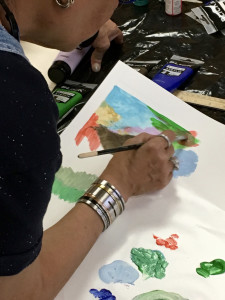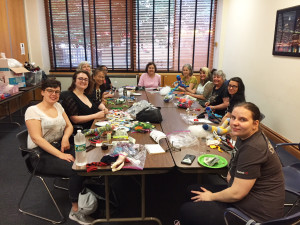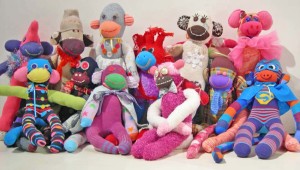
by Eleanor J. Bader
Fresh Art for Social Change…and Healing
 There is a photocopied sign on the wall of art administrator Suzanne Kreps’ cluttered office: “Change will not come if we wait for another person or some other time…We are the ones we’ve been waiting for…We are the change that we seek.”
There is a photocopied sign on the wall of art administrator Suzanne Kreps’ cluttered office: “Change will not come if we wait for another person or some other time…We are the ones we’ve been waiting for…We are the change that we seek.”
The quote, attributed to former President Barack Obama, reinforces Kreps’ commitment to using art to promote social justice. She’s done this for 16 years, as the executive director of fresh art, a small, New York City-based non-profit that organizes fine art and craft workshops for underserved and disadvantaged adults— seniors, women and men in recovery from chemical dependencies, the homeless, the mentally ill, and people with HIV, AIDS, mental illnesses and physical and emotional disabilities. It also organizes exhibitions of their work.
As Kreps prepares to retire at the end of 2019, she sat down with Eleanor J. Bader to look back on her work with the organization.
Eleanor J. Bader: Let’s start with history. How and when did fresh art begin?
Suzanne Kreps: Wendy Grossman founded fresh art in 1997 and started its programming in 1999. Wendy had been working as a recreational therapist at the now-defunct John Heuss House, a drop-in center for homeless men and women living with mental illness, that was located in Lower Manhattan. This was in the late 1990s. Wendy’s job included organizing group activities as well as art classes, other recreational programming, and activities emphasizing daily living skills. In 1997, she mounted “Inside Out”, a show of works created by the participants. My partner, Clarke, who also worked at John Heuss House, suggested that Wendy contact me since I was working at OK Harris Gallery. I knew a fair amount about arranging exhibitions, so he thought I could help. I assisted in the installation of that show and later became a member of an Advisory Board that helped Wendy form fresh art.
The idea of starting a non-profit arts organization had been with Wendy for some time. She envisioned an organization that would provide programming to a wide-range of underserved and at-risk populations—including disadvantaged youth, homeless and formerly homeless individuals, people with disabilities, and low-income and isolated seniors.
 Wendy eventually left Heuss House and with the help of the New York Foundation for the Arts– the fiscal sponsor of the organization while it waited for its 501(c 3) status — she was able to get the fledgling organization off the ground. She began running the organization out of her family’s fifth floor walk-up apartment in the East Village.
Wendy eventually left Heuss House and with the help of the New York Foundation for the Arts– the fiscal sponsor of the organization while it waited for its 501(c 3) status — she was able to get the fledgling organization off the ground. She began running the organization out of her family’s fifth floor walk-up apartment in the East Village.
From the beginning, fresh art arranged exhibitions to showcase the creativity of artists from the populations I just mentioned. One of the first was called “Wild Kingdom” and every piece had something to do with animal life. The art came from programs at the Bowery Residents Committee, St. Francis Residence III in Manhattan, Harlem Hospital, The Point in the Bronx, and five additional NYC organizations.
In April of 1999 the exhibition was installed at CB’s 313 gallery space on the Bowery, located next door to CBGBs. During the next two years, exhibitions were planned at other venues.
Then, in the summer of 2001, Wendy found a rental space in the basement of Washington Square United Methodist Church, another site that no longer exists. It opened in August 2001, a month before September 11th. The space was part office, part gallery, and part gift shop where artworks and crafts by artists affiliated with other non-profit agencies were for sale; fresh art stayed open in this spot until 2003.
EJB: Why did you leave this space?
SK: Before September 11th, Wendy had been able to get several grants; after the attacks, funding dried up and the focus of philanthropy turned to recovery efforts. Fresh art was also undergoing a transition. By 2003 Wendy and her family were planning on moving out of state. I’d been helping her as Exhibitions Director on weekends and evenings, but my involvement was limited because I had a fulltime job at the gallery. Before Wendy left in 2003, she asked me to take over as Executive Director. I was not knowledgeable about non-profit management, so I was reluctant but I eventually agreed.
EJB: Did fresh art open another office after leaving the church basement space?
 SK: Before Wendy left New York, we met with Elizabeth Marks at Hospital Audiences Inc. [HAI], a group fresh art had previously worked with. HAI provided access to music, dance, theater, and the visual arts to people who might otherwise have no access due to hospitalization, disability, or poverty. Like fresh art, HAI also ran workshops for people with mental and emotional disabilities and some of their artists’ works had been exhibited in our shows. Following suggestion made by Elizabeth, HAI’s director, Michael Jon Spencer, agreed to give us desk space and we remained at HAI for about 10 years.
SK: Before Wendy left New York, we met with Elizabeth Marks at Hospital Audiences Inc. [HAI], a group fresh art had previously worked with. HAI provided access to music, dance, theater, and the visual arts to people who might otherwise have no access due to hospitalization, disability, or poverty. Like fresh art, HAI also ran workshops for people with mental and emotional disabilities and some of their artists’ works had been exhibited in our shows. Following suggestion made by Elizabeth, HAI’s director, Michael Jon Spencer, agreed to give us desk space and we remained at HAI for about 10 years.
At that point I was working six days a week, with the two jobs, and it was thanks to the generosity of Ivan Karp, the founder and director of OK Harris that I was given flexibility to work fewer days at the gallery and continue with fresh art on my “off” days.
HAI eventually moved to Queens, and fresh art moved to St. Margaret’s House, a residence for low-income seniors and the disabled in downtown Manhattan, near the South Street Seaport. We’ve been at St. Margaret’s House since 2013. Since 2006 we had been conducting a painting workshop for the residents of St. Margaret’s House and community, many of whom have never painted or drawn before. We have also worked with numerous other agencies over the years, implementing workshops on site to bring art to their clients.
EJB: I discovered fresh art at a street fair where volunteers were selling handmade sock monkeys to benefit the organization. How did this develop? How much of your budget comes from the sale of these adorable, handmade critters?
SK: Sometime after Wendy had her first daughter in the early 2000s, the baby received a gift of a sock monkey. This prompted Wendy to think about making and selling them. Shortly thereafter, she and I did a sock monkey sewing workshop with teenage girls at the Grand Street Settlement House.
 With the thought of selling the monkeys at fresh art’s gallery/gift shop, Wendy placed an online request through New York Cares asking for sewing volunteers. A small group responded and came to the gallery/gift shop to make them, meeting every other Monday evening. As of the last count of sales, we’d created more than 3400—each of them reflecting the personality of the sewer. The monkeys we’ve sold were made by volunteers, but we’ve also had workshops for women living in homeless shelters where they have an opportunity to make their own sock monkeys. We have sold the handmade animals via our website as well as at craft fairs. A few stores have carried them, as well. I have to say, during the recession of 2007 and 2008, we would have had to close shop had it not been for the income provided by the monkeys.
With the thought of selling the monkeys at fresh art’s gallery/gift shop, Wendy placed an online request through New York Cares asking for sewing volunteers. A small group responded and came to the gallery/gift shop to make them, meeting every other Monday evening. As of the last count of sales, we’d created more than 3400—each of them reflecting the personality of the sewer. The monkeys we’ve sold were made by volunteers, but we’ve also had workshops for women living in homeless shelters where they have an opportunity to make their own sock monkeys. We have sold the handmade animals via our website as well as at craft fairs. A few stores have carried them, as well. I have to say, during the recession of 2007 and 2008, we would have had to close shop had it not been for the income provided by the monkeys.
I think each and every one of the monkeys has great style. I don’t know what it is about them, but people just seem to love them.
EJB: How much work is involved in making each one?
SK: A lot! One of our volunteers can create one in about two hours but it usually takes a lot longer, I’d say, eight or more hours.
EJB: How have you used the revenue that is raised?
SK: It has shored up our funding for workshops. We do get funding from the New York City Department of Cultural Affairs, The Milton and Sally Avery Arts Foundation and individual donors, but every $35 sale has helped us operate.
EJB: I know you are preparing to retire from fresh art… Does anything stand out as a proudest moment or biggest achievement?
SK: Hmmmm. Well, there are several. Seven years ago we were contacted by Café Art, a non-profit based in London that exhibits the work of homeless artists in cafes across England. The director of Café Art, Michael Wong, found us online and emailed me. Since this initial contact in 2013, we’ve sent paintings and drawings made by formerly homeless and disadvantaged New Yorkers to him every spring. He collects artwork from non-profit groups that work with creative, homeless individuals from major cities around the world — Auckland, Berlin, London, Melbourne, Mumbai and New York City. He then sends each city a sampling of this art – eight to ten pieces — and each city mounts a summer exhibition. The exhibitions’ intent is to highlight not only the need for housing worldwide but to emphasize the creativity of homeless individuals.
I am also proud that one of our workshop volunteers was so inspired by the work she did with a developmentally disabled artist that she went back to school to become an art therapist.
But most proud? I am proud that fresh art has been able to provide underserved folks with an opportunity to express themselves and, for a few hours a week, maybe feel a little better about their lives. I hope this has made a lasting difference for them.
Eleanor Bader is a freelance writer living in New York City.